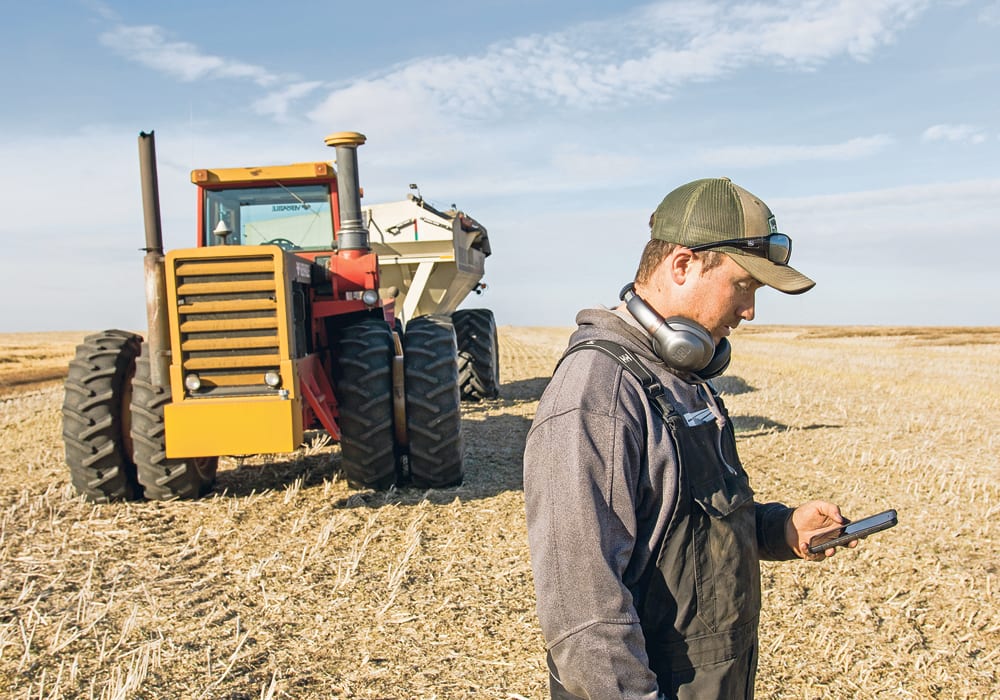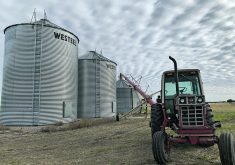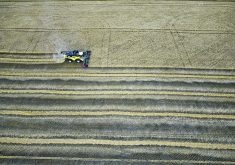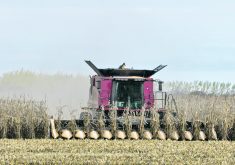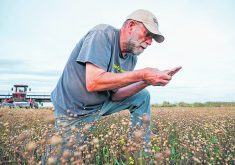Alberta:
Unfavourable weather conditions over the past month have left millions of acres unharvested on the Prairies at a time when most should be combined.
The bulk of what’s left in the field is primarily located in northern and central Alberta, northern Saskatchewan and in northwestern and southwestern Manitoba, according to last week’s crop reports.
The situation has left many farmers feeling frustrated. With grain dryers running non-stop, costs of production are escalating. The grain that’s coming out is of lower quality, taking a bite into revenues.
Read Also

Farming Smarter receives financial boost from Alberta government for potato research
Farming Smarter near Lethbridge got a boost to its research equipment, thanks to the Alberta government’s increase in funding for research associations.
“Much of the wheat crop will be downgraded to feed, even after drying, resulting in losses of up to $240 million from milling quality,” Alberta Wheat Commission chair Kevin Bender said in a news release.
Representatives with Alberta’s crop commissions are urging the province to be prepared for unharvested claims this year. They suspect the crop that’s still out there is worth roughly $3 billion.
“We remain hopeful farmers can get back to harvesting, but 2018 will be a major hit to the bottom line,” Bender said.
Alberta Agriculture Minister Oneil Carlier has said he understands it’s been a tough year, though he can’t yet speculate how many unharvested claims there will be. He recommended farmers keep in contact with the Agriculture Financial Services Corp.
“It’s something AFSC has the programs in place to deal with it,” he said.
“We’ll have a better handle on those numbers as harvest progresses.”
Alberta is furthest behind with only 40 percent complete overall. In the central, northwestern, northeastern and Peace regions, harvest progress ranges from 16 to 43 percent complete. It means roughly 12.5 million acres have yet to be harvested in Alberta. The province is usually 82 percent done by this time of year.
Lac Ste. Anne County, 100 kilometres northwest of Edmonton, recently declared a state of agricultural disaster due to feed shortages and extremely delayed harvest. The county is usually 63 percent done, but has only 16 percent of crops in the bin.
East of Alberta, similar stories of delays have emerged.
In Saskatchewan, areas around North Battleford, Prince Albert, Tisdale and Canora are approximately halfway complete. About 22 percent, or eight million acres, are still unharvested province-wide, the bulk of that being in those northern areas.
“It’s not unusual for the northwest to be wet or see snow at this time, but what is unusual is how long it’s been with this moisture,” said Shannon Friesen, a crops extension specialist with Saskatchewan Agriculture.
In Manitoba, the Roblin and Swan River areas are fairly behind in canola harvest with roughly 40 percent of the crop in the bin. Soybean harvest there has got a slow start with 10 percent complete.
“My fingers are crossed for conditions to turn around and get a nice stretch of ideal drying harvest weather in order for things to wrap up,” said Nicole Clouson, a farm production extension specialist with Manitoba Agriculture in the region.
In total, about 22.5 million acres remain unharvested. That number was calculated by multiplying the percentage of unharvested acres in each province by their number of total seeded acres this spring. The number of seeded acres is supplied by Statistics Canada.
The areas that are mostly finished are in southwestern and southeastern Saskatchewan (roughly 90 percent done), as well as in central and eastern Manitoba and the province’s Interlake region (roughly 80 percent).
While southern Alberta is 71 percent finished, it’s still fairly behind its five-year average of 91 percent completion.
“It’s fair to say it has been a difficult month,” said Mark Cutts, a crop specialist with Alberta Agriculture.
“Obviously it’s frustrating to sit and go through this for a lengthy period of time.”
However, the crop specialists say all is not yet lost. Cutts said it would be worse if farmers were facing this same scenario during the first week of November. Long-term forecasts into mid-October indicate warm temperatures and sunny skies.
“This is not an ideal situation, but it’s not something we haven’t dealt with in the past,” Friesen said.
“As long as the weather improves and we get dry weather, that would be helpful. Warm weather would also be helpful.”
Unharvested crops by province
Alberta:
- Seeded about 21 million acres in 2018 and about 40 percent of all crops are harvested, meaning 60 percent, or 12.5 million acres, are unharvested.
Saskatchewan:
- Seeded roughly 37 million acres in 2018, and 78 percent of crops are harvested, meaning 22 percent, or about eight million acres, are unharvested.
Manitoba:
- Seeded roughly 10 million acres in 2018, and 80 percent of crops are harvested, meaning 20 percent, or about two million acres, are unharvested.




